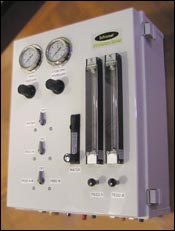New Takes on Thermal Spray
Ceramic nanocoatings take on tough applications.
Thermal spray is a well-established technology that can rapidly apply a wide variety of coating materials. In conventional Air Plasma Spray (APS) thermal spray technology, the coating feedstock in powder form is injected into a plasma stream, where the powder particles are heated and accelerated with a carrier gas toward the substrate surface. The molten or softened feedstock particles are applied by impact onto the substrate, rapidly building a deposit.
Now one company is commercializing thermal spray technology that results in a nanostructured deposit with unique properties. According to Inframat Corp. (Farmington, CT), its thermal spray coatings possess unusual properties attributable to their nanoscale grain structure rather than the physical dimensions of the coating layers, which are relatively thick at 10–20 mils.
The company says its patented thermal spray ceramic nanocoatings are of special interest because traditional chrome and conventional ceramic coatings can have serious deficiencies in terms of brittleness and adhesion.
Nano-size particles cannot be sprayed as-is. Thus, the nanoparticle feedstock is reconstituted into agglomerates approximately 50 μm in diameter. Research has shown that spraying at a middle temperature range results in partial melting of the agglomerate and yields regions of micron-sized grains surrounded by nanoscale grains from the fully melted material. Inframat says this provides the best coating properties.
The key to the unique properties shown by its nanostructured coatings is grain size. In coatings, the ratio of the number of atoms residing at grain boundaries to the number of atoms at grain interiors plays a critical role in material properties. As grain size decreases and reaches the deep nanoscale, a large fraction of the atoms reside at the grain boundaries, lacking long range order. In materials with a grain size of 10 nm, as many as 50% of atoms are at grain boundaries. Quantum mechanical interactions dominate in this regime, overturning classical behavior. The result is ceramic nanocoatings with properties one normally would not expect from ceramic materials, such as good ductility and impact resistance.
Initially developed in collaboration with the University of Connecticut (Storrs) under funding from the Office of Naval Research, Inframat’s alumina-titania nanocoatings were found to be exceptionally effective at preventing the buildup of sea mollusks and other critters on the hulls of naval vessels. In fact, it has been reported that these nanocoatings save the Navy an average of more than $34 million in maintenance costs over the lifetime of each vessel.
The company’s Al2O3-13TiO2 ceramic nanocomposite is a commercial product available under the Nanox 2613 brand name. According to the U.S. Navy, the coating has “exhibited wear resistance, bond strength, and toughness unprecedented in a ceramic, and is now in use aboard Navy surface ships and submarines, reducing maintenance costs due to wear and corrosion.” Toughness, or the ability to withstand an impact or applied strain is a key attribute of ceramic nanocoatings, allowing their use in areas where no other coatings could be used—for example, on propeller shafts, which undergo severe torsional strain.
Inframat has also been pioneering a novel approach to thermal spray coatings, called Solution Plasma Spray (SPS), since its inception in 1996. The company says SPS eliminates labor-intensive manufacturing of powder feedstocks of a given reconstituted particle size, particle size distribution, composition, morphology, and flow characteristic. This removes quality problems associated with classification of the feedstock in the laborious process of removing the tails (fines and boulders) from the Gaussian particle size distribution.
The company says SPS coating materials essentially have no particle size distribution, just a single-valued δ function. This would enable production of, for example, true gradient coatings by metering and ratioing the relative compositions at the solution feedstock reservoirs to smoothly alter stoichiometry in real time, with no need to have premixed powder compositions.
According to Inframat, this can all be achieved by choosing salts of the active species that are soluble in aqueous (or other) solutions or by using slurries. The solutions are then mixed, atomized to form liquid droplets and injected in the hot plasma.
In addition to nanostructured thermal spray materials, the company has developed a commercial SPS delivery system. It is a wall-mountable unit with dual flow and pressure controls, and the company says it can easily be retrofitted to a variety of commercial plasma spray systems.
Read Next
Education Bringing Cleaning to Machining
Debuting new speakers and cleaning technology content during this half-day workshop co-located with IMTS 2024.
Read MoreDelivering Increased Benefits to Greenhouse Films
Baystar's Borstar technology is helping customers deliver better, more reliable production methods to greenhouse agriculture.
Read MoreEpisode 45: An Interview with Chandler Mancuso, MacDermid Envio Solutions
Chandler Mancuso, technical director with MacDermid Envio discusses updating your wastewater treatment system and implementing materials recycling solutions to increase efficiencies, control costs and reduce environmental impact.
Read More














.jpg;maxWidth=300;quality=90)






